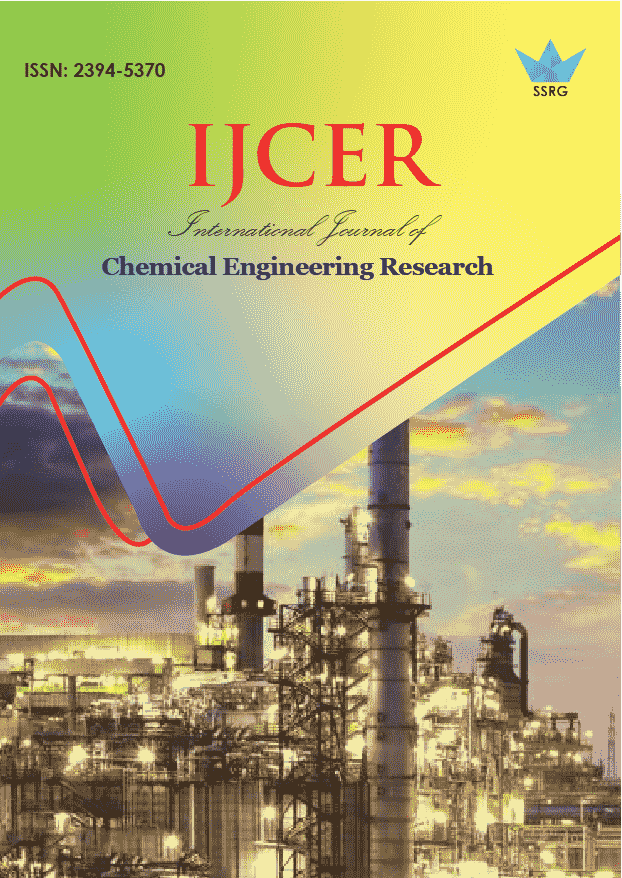Purpose of Ozone and Oxygen to Decrease Chemical Oxygen Demand and Hydrogen Sulfide from an Improved Paper Dispensation Plant

| International Journal of Chemical Engineering Research |
| © 2015 by SSRG - IJCER Journal |
| Volume 2 Issue 1 |
| Year of Publication : 2015 |
| Authors : R.Sreemathi, Dr.M.Sathiyakala |
How to Cite?
R.Sreemathi, Dr.M.Sathiyakala, "Purpose of Ozone and Oxygen to Decrease Chemical Oxygen Demand and Hydrogen Sulfide from an Improved Paper Dispensation Plant," SSRG International Journal of Chemical Engineering Research, vol. 2, no. 1, pp. 5-9, 2015. Crossref, https://doi.org/10.14445/23945370/IJCER-V2I1N2P101
Abstract:
A pilot learning was performed at the Fox River Fiber improved paper dispensation company in DePere, Wisconsin, to establish the amount to which inoculation of oxygen and ozone could decrease the high chemical oxygen command, COD, in the sewage and the efficiency of the ozone/oxygen stream in suppressing construction of hydrogen sulfide gas in downstream sewage appearance. Adaptive Ozone Solutions, LLC, complete the oxygen/ozone making and injection scheme. Samples were analyzed both before and after oxygen/ozone insertion. Hydrogen sulfide gas was incessantly monitored at sewer stations downstream of Fox River filament. Consequences showed that with an extremely short contact time, effluent COD was concentrated by over 20%. A straightforward kinetic model predicts that a contact time of fewer than 40 minutes possibly will decrease COD by as much as 65%. In calculation, downstream hydrogen sulfide gas manufacture in the sewage mains was also improved proscribed, such that expensive Bioxide applications could be concentrated. Hydrogen sulfide gas, fashioned as an effect of these conditions, is the most common odorous gas found in municipal wastewater compilation and management systems.
Keywords:
COD, Thiobacillus, GBMSD
References:
[1] Patricia A. Terry, Application of Ozone and Oxygen to Reduce Chemical Oxygen Demand and Hydrogen Sulfide froma Recovered Paper Processing Plant, Hindawi Publishing Corporation International Journal of Chemical Engineering Volume 2010, Article ID 250235, 6 pages, 2010.
[2] C. Ishida, A. Salveson, K. Robinson, R. Bowman, and S. Snyder, “Ozone disinfection with the HiPOX reactor: streamlining an “old technology” for wastewater reuse,” Carollo Engineers, Applied Process Technology and Southern Nevada Water Authority, 2007.
[3] W. Viessman, J. Hammer, E. Perez, and Chadik P., Water Supply and Pollution Control, Pearson Publishing, 8th edition, 2009.
[4] D. E. Phares, D. M. Rokjer, I. A. Crossley, and J. J. Franko, “Modeling and validating the effective hydraulic detention time for a 10 mgd ozone contactor at the lake Washington surface water treatment plant, Melbourne, Florida,” Ozone Science and Engineering, vol. 31, no. 3, pp. 262–276, 2009.
[5] N. Takahashi and T. Kumagai, “Application of ozonation to dyeing wastewater treatment—case study in Nishiwaki treatment plant,” Ozone Science and Engineering, vol. 30, no. 6, pp. 439–446, 2008.
[6] Ried, J. Mielcke, and A. Wieland, “The potential use of ozone in municipal wastewater,” Ozone Science and Engineering, vol. 31, no. 6, pp. 415–421, 2009.
[7] E. E. Richardson, A. Hanson, and J. Hernandez, “Ozonation of continuous-flow activated sludge for reduction of waste solids,” Ozone Science and Engineering, vol. 31, no. 3, pp. 247– 256, 2009.
[8] S. Rahman, “Sealing our buried lifelines: understanding how rubber gaskets are designed to function in municipal pipe joints is critical to sound decision making in the field,” American Water Works Association, pp. 12–17, April 2007, http://www.awwa.org/communications/opflow.

 10.14445/23945370/IJCER-V2I1N2P101
10.14445/23945370/IJCER-V2I1N2P101